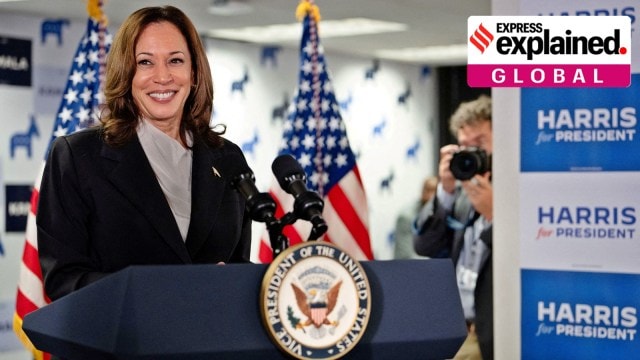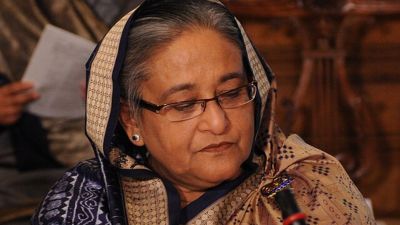The rise of Kamala Harris, and what her likely presidential nomination signifies
If officially selected to replace Biden in the elections, Kamala Harris would be the first woman of Asian and Black heritage on the ballot at a time of increased polarisation in US politics. Here is the brief story of her rise and the implications of her candidacy.
 U.S. Vice President Kamala Harris speaks at her Presidential Campaign headquarters in Wilmington, DE, U.S., July 22, 2024. (Erin Schaff/Pool via REUTERS)
U.S. Vice President Kamala Harris speaks at her Presidential Campaign headquarters in Wilmington, DE, U.S., July 22, 2024. (Erin Schaff/Pool via REUTERS)(Written by Saima Mehta)
Announcing his decision to step down from the 2024 presidential race on Sunday (July 21), US President Joe Biden endorsed Vice President Kamala Harris as the new party nominee. He said, “My very first decision as the party nominee in 2020 was to pick Kamala Harris as my Vice President. And it’s been the best decision I’ve made.”
She won’t become the nominee right away, but her political position, age, and the diverse demographics she represents gives certain advantages. It helps that there is no major challenger from her party on the horizon.
Harris’ likely nomination as the party’s official candidate for the November polls would be historic, as it was in 2020, when she became the first woman, Black, and South Asian Vice-President of the United States.
With Indian-Jamaican parents, a journey of firsts
Kamala Harris was born on October 20, 1964, in Oakland, California. Her mother Shyamala Gopalan was a distinguished breast cancer researcher from Chennai in India, while her father Donald Harris was an economist from Jamaica.
This multicultural heritage influenced Harris’ worldview and career path. Reflecting on her journey, she has said, “My mother would look at me and say, ‘Kamala, you may be the first to do many things, but make sure you are not the last.’”
She enrolled in Howard University and later the University of California College of the Law. She joined the California Bar and then the Alameda County District Attorney’s Office, specialising in prosecuting child sexual assault cases.
Rise from District Attorney to US Senator
A key moment in Harris’ political journey was in 2003, when she was elected as the District Attorney of San Francisco. In 2010, she was elected Attorney General of California, where she championed progressive policies, including consumer protection and criminal justice reform.
She later reflected in her memoir, “My vision of a progressive prosecutor was someone who used the power of the office with a sense of fairness, perspective and experience, someone who was clear about the need to hold serious criminals accountable and who understood that the best way to create safe communities was to prevent crime.” Her national profile rose further as she took on crucial roles in advocating for issues like healthcare and immigration.
However, Harris has also faced criticism, particularly from progressive groups. According to a Reuters report, her approach to truancy laws, which involved prosecuting parents of chronically truant children, was viewed by many as punitive and disproportionately affecting low-income and minority families.
In 2016, Harris became the US Senator from California. She gained recognition for questioning during committee hearings and her advocacy on critical issues like climate change, healthcare, and criminal justice reform. Her legislative work laid the groundwork for her rise to the national stage.
Becoming Vice President: a historic milestone
In 2020, Kamala Harris made history with her appointment as Vice President. It also marked a milestone in American politics, showcasing the diversity within American political leadership. As President of the Senate, Harris cast a record number of tie-breaking votes by any Vice President.
In one such instance, she secured the passage of the landmark Inflation Reduction Act, aimed at addressing inflation, climate change, and healthcare costs in the United States through large investments.
One of the weakest points of the Biden administration has been its inability to deal with the crisis on its southern border, with record numbers of immigrants entering the US illegally in the last few years. Many have blamed Harris, as Biden gave her the responsibility of addressing the root causes of high immigration from some countries to the US. Democrats have also criticised her for telling immigrants to “not come”.
Potential nomination and its implications
As the first woman of South Asian and Black heritage to potentially be on the ballot for the highest office, her candidacy also highlights the emergence of broader political representation. It reflects the diverse and multiracial American demographic landscape.
A 2019 article in The Conversation noted, “The white share of the U population has been dropping, from a little under 90% in 1950 to 60% in 2018. It will likely drop below 50% in another 25 years.”
According to data from the United States Census Bureau in 2020, the multiracial population in the US accounted for about 10.2% of the total population. This number rose from 9 million in 2010 to 33.8 million in 2020 — a rise of 276%. The South Asian American community is also one of the fastest-growing groups in the US. The “Asian Indian” population category, in particular, experienced a 56% increase from 2.8 million in 2010 to 4.4 million in 2020.
Harris’ candidacy could shape the Democratic Party’s approach to issues like immigration, healthcare, and women’s rights. A progressive platform would also position her in stark opposition to the politics of former President Donald Trump.
However, her win against the Republican candidate is far from certain. She is not known to be a particularly charismatic leader, especially compared to the popularity Trump enjoys among his supporters, and does not have time on her side.
Recent opinion polls — conducted before the assassination attempt against Trump and before Biden’s withdrawal — reveal a tight race. An average of 11 polls published by The Washington Post on July 21 showed Trump was “slightly” leading Harris. This was after the first televised debate between Trump and Biden on June 27, where Biden’s weak performance led to calls for his replacement.
The author is an intern with The Indian Express




- 01
- 02
- 03
- 04
- 05


































